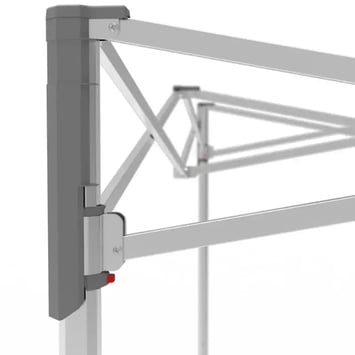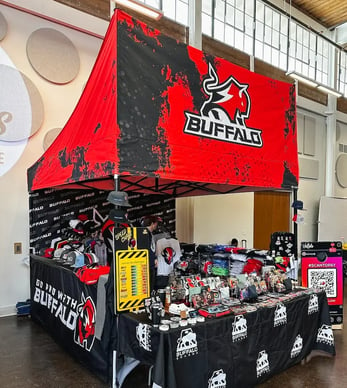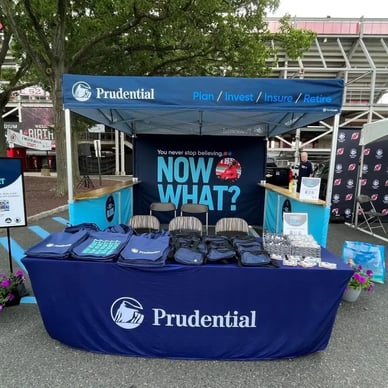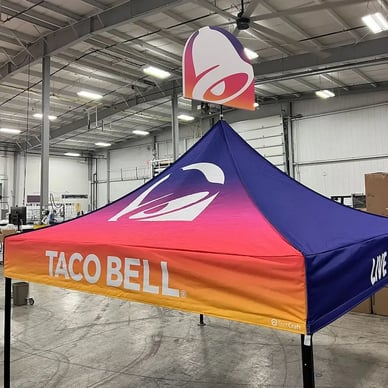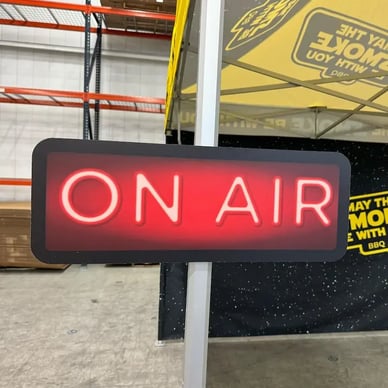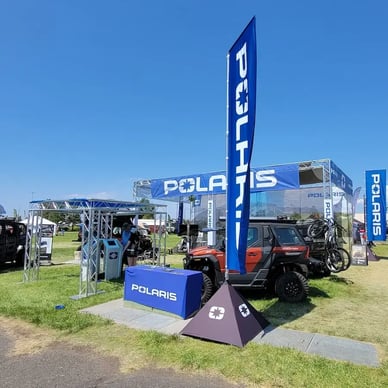Custom Pop-Up Tent FAQs: The Most Asked Questions
Purchasing your first custom pop-up canopy tent for your business, whether for selling food, showcasing wares, or exhibiting at an event, might initially seem straightforward.
But when you actually dive into the process, you quickly learn there are A LOT of steps to take and questions to answer in order to finalize your order and ensure your tent is absolutely perfect.
At TentCraft, we understand the intricacies of purchasing a custom pop-up tent better than anyone else. That’s because we manufacture the entire tent — frame and canopy — 100% in America, from our production facility in Traverse City, Michigan. The other guys import frames from overseas and tend to focus on the volume of sales, not quality.
Our decision to control quality instead of importing it makes us the ideal resource for answering all of your questions through this buying journey and navigating you each step of the way with confidence.
Below you’ll find the most frequently asked questions during the custom pop-up tent buying process.
Cost, Shipping, and Warranty of a Custom Pop-Up Tent
Our prospective customers typically start here: How much is this tent going to cost me?
How much does a custom pop-up tent cost?
A custom pop-up tent can cost as little as $500 for a cheap option and as much as $5,000 for an engineered, large-scale model. When prospective customers ask us how much their tent will cost, we start with, “Well, it depends…” before explaining the many factors that dictate a final price.
Commonly, a customer wants a starting price for a printed 10x10 pop-up canopy tent with no walls. Our American-made, heavy-duty MONARCHTENT starts at $3,099. MONARCHTENT comes with certified wind ratings and a lifetime frame warranty. It’s the strongest tent in its class and the only pop-up tent that’s engineered and designed in the United States to stand up to tough winds.
Our 10x10 medium-duty solution, mightyTENT, stars at $1,999 fully printed.
You don’t have to search very long to see there’s a huge price range for 10x10 pop-up tents. E-Z UP sells a cheap tent for $400. Amazon has an option for $500.
If you’re looking for shade at your kid’s weekend soccer game, one of those cheaper options will probably work well enough for you for a season or two, depending on the weather.
But if you’re a business that relies on events to promote your business or sell food or goods, you’ll likely want to invest in a quality product that protects your brand, your people, and your bottom line.
Why do TentCraft tents cost more than competitor tents?
Pop-up tents have become a commodity business where sellers attempt to cut as many costs as possible and win the volume game. At TentCraft, we’re focused on building high-quality tents that last a ridiculously long time.
Our pop-up tents tend to be more expensive for a few reasons:
-
We manufacture 100% in the USA out of a production facility in Traverse City, Michigan. We believe in American manufacturing because we experience first-hand how we can better control quality and build custom tents and structures that no one else can do.
- We back up our heavy-duty pop-up tents with a lifetime frame warranty. MONARCHTENT is the only tent in its class to include a lifetime frame warranty — that’s how much confidence we put behind our quality thanks to the decision to build it in the U.S.
- They’re engineered for unpredictable wind and rain. Our tent frames are the only tents in their class to come with certified wind ratings from an actual engineering firm. We include a safety factor in our ratings and have immense confidence that our tents, when properly ballasted, can stand up to 35 mph winds.
- Design and customer service. We know buying a custom pop-up tent isn’t easy, so we employ a team of project managers to hold your hand through the entire project. Need some design help? We have a team of artists waiting to create a masterpiece. E-commerce-style businesses rely on you to properly upload your logo and any text or artwork. If the resolution isn’t quite right, you’ll see how blurry it is once it arrives on your doorstep. At TentCraft, our entire team makes sure your tent is as perfect as possible and will point out issues like resolution or color management.
We like to tell customers that they will pay more money upfront for a TentCraft solution, but they ultimately save money — and time — down the road by not having to replace yet another cheap solution.
How long does it take to build and deliver a custom pop-up tent?
The turnaround time for a custom pop-up tent varies by company. Companies that import frames from China typically have a longer turnaround time of 1-2 weeks. When the global supply chain is bogged down, your order could take more than a month to fulfill.
TentCraft sources and fabricates its aluminum for pop-up tents in the United States, allowing us to turnaround custom tent jobs in as little as three days. We can move even faster in some situations if you’re in a real jam for your event.
As a bonus, you don’t need to worry about your frame getting damaged when it’s traveling to the U.S. on a cargo ship. We handcraft our frames in-house in Traverse City, Michigan.
What is the typical warranty on a custom pop-up tent?
Most custom pop-up tent companies offer a three- to five-year warranty on their product.
At TentCraft, we put so much confidence behind our heavy-duty pop-up tent that we offer a lifetime frame warranty, making us the only company to offer that length of warranty.
The canopy comes with a seven-year, pro-rated warranty.
Pop-Up Tents In Wind and Rain
If you’re shopping for a pop-up canopy tent, one of your main concerns is probably around how well it stands up to wind and rain.
Can a pop-up canopy tent be waterproof?
No, but a pop-up canopy tent can be water resistant. It sounds similar, but there’s a big difference.
Waterproof means if rain hits the canopy, it instantly repels and stays dry. That isn’t possible.
Water resistant means the canopy is strong enough to prevent pooling during heavy rains when the tent is properly installed.
At TentCraft, we manufacture our canopies using a special 600D polyester material called Duranti. This is the thickest fabric on the market that’s still flexible enough to attach to a tent frame. Our proprietary material, called Duranti, also includes a specific tensile strength and thread density that reduces water pooling during heavy rains.
Can I leave my pop-up tent up for an extended period of time?
It’s best to always keep the weather in mind when leaving your pop-up tent up for an extended period of time — and err on the side of caution.
If you’re activating at a multi-day event, we would recommend taking down your pop-up tent at night to ensure it’s not damaged by unpredictable weather.
At TentCraft, our team of engineers have designed MONARCHTENT with certified wind ratings of 35 mph when properly ballasted. If wind gusts exceed this limit, however, we strongly recommend taking the tent down. In such extreme conditions, continuing the event becomes unsafe for everyone involved, so it’s best to prioritize safety over keeping the tent up.
How much wind can a pop-up canopy tent handle?
A well-constructed pop-up canopy tent can handle winds of about 30 mph when properly ballasted. The TentCraft MONARCHTENT is engineered with 35 mph certified wind ratings.
When searching for a heavy-duty pop-up tent, you’re going to come across companies that advertise their tents sustaining 75 mph winds. We think those marketing claims are a bit irresponsible for a couple of reasons.
One, these tests are done using a controlled wind tunnel machine that doesn’t replicate the real-world swirling, crossing, and lifting of wind. It just shoots in one direction.
And secondly, who in their right mind is going to be outside in a storm producing 75 mph winds, which is the same speed as a category 1 hurricane? It’s not safe. You should never keep your pop-up tent set up with winds that high.
What are the best ways to anchor a canopy tent?
Staking is the best way to secure a pop-up tent. You can use stakes on grass, gravel, or dirt.
Pop-up canopy tents, however, are commonly set up in parking lots and other hard surfaces. So, the other best ways to anchor your tent include:
-
Sand Bags: This option is cheap and accessible, but sometimes not heavy enough.
-
Water barrels: Large water barrels are overkill for pop-up tents, but great options for large, semi-permanent frame tents.
-
Concrete blocks: Concrete cinder blocks are easy to find, but only typically weigh about 28 lbs, which isn’t always enough weight. In a pinch, they get the job done.
-
Footplates: This the best looking and most reliable ballasting option. At TentCraft, we manufacture cast-iron footplates that weigh a little more than 50 lbs. each — more than enough weight to ballast your pop-up tent.
How much weight do I need to hold down my pop-up canopy tent?
The weight needed to hold down a pop-up tent depends on the size of the tent and the overall weight of the tent frame and canopy.
We always recommend staking your tent into the ground when possible. If you’re setting up on a hard surface, like concrete, though, you’ll need to use weighted footplates or sandbags.
About 200 lbs. is needed to properly secure a 10x10 pop-up tent. Even more weight — 370 lbs. — is needed for ballasting a 10x20 pop-up tent.
Pop-Up Tent Designs & Sizes
From size to canopy styles, these are the most asked questions about pop-up tent designs.
Can you connect pop-up tents together to create a larger footprint?
You can absolutely connect multiple pop-up tents to create a larger footprint. At TentCraft, we often have clients who invest in multiple 10x10 pop-up tents to create 10x20 or 10x30 spaces.
To accomplish this, we recommend purchasing connecting clamps to stabilize your entire tent activation.
What are the main differences between a 10x10, 10x15, and a 10x20 pop-up tent?
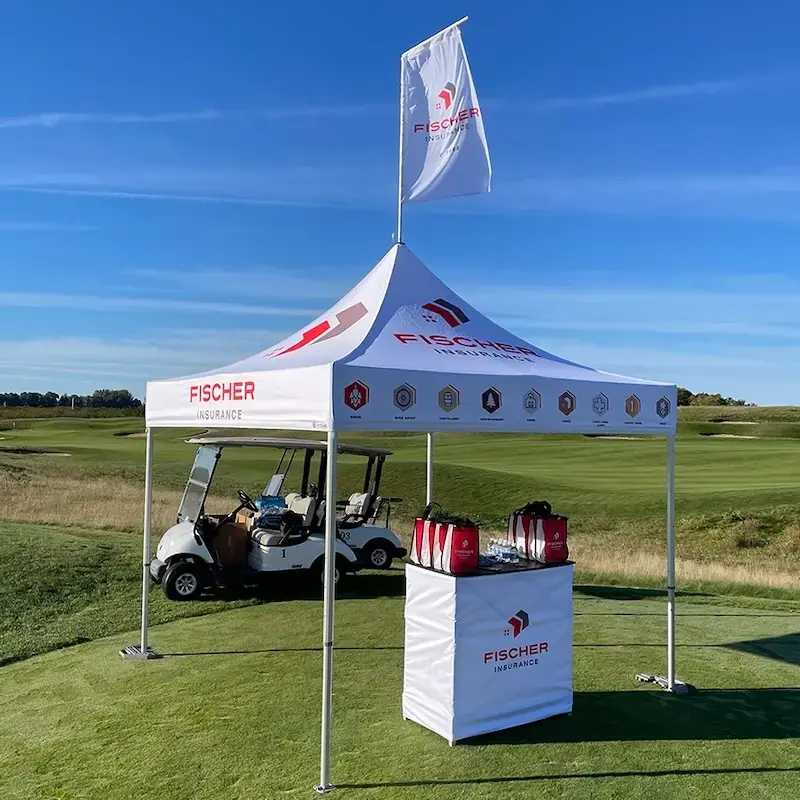
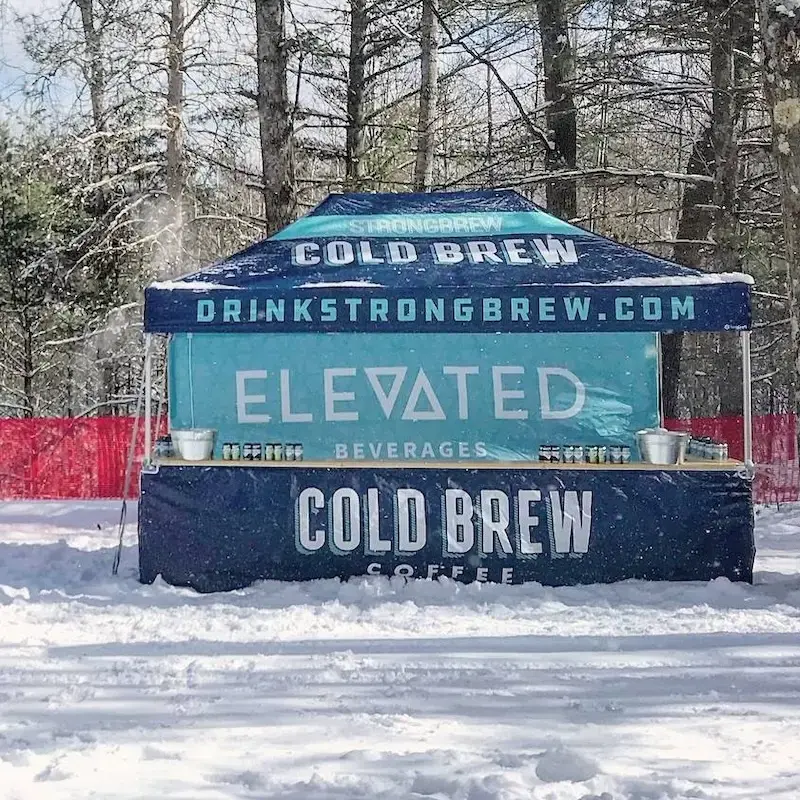
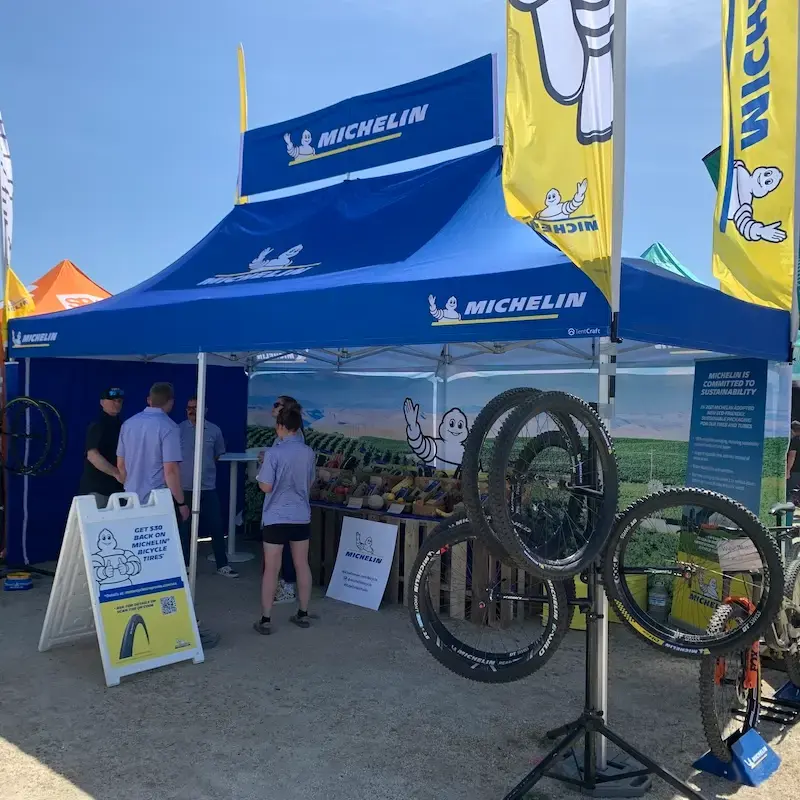
There are a few main differences between these three sizes of pop-up tents.
The obvious difference is the amount of square footage underneath the tent: 100 square feet for a 10x10; 150 square feet for a 10x15; and 200 square feet for a 10x20.
The next big difference, though, is the number of legs. Our engineering team designed our 10x10 and 10x15 using four (4) legs. When you go up to 10x20, we add two legs to the middle for a total of six (6) legs.
By going with six legs on our 10x20, we’re able to add stability and achieve the 35 mph certified wind ratings for that size tent.
In terms of the overall weight of the frame and canopy together…
-
10x10 weighs 76 lbs.
-
10x15 weighs 122 lbs
-
10x20 weighs 149 lbs.
In terms of the cost of a fully printed, custom pop-up canopy tent…
-
10x10 starts at $3,099
-
10x15 starts at $3,999
-
10x20 starts at $4,699
How much do pop-up canopy tents actually weight?
Pop-up canopy tents can vary in weight, but if durability and stability is important to you, then you need to pay attention to the total weight.
You want your pop-up tent to be heavy enough to sustain heavy winds, but light enough to make it easy to transport. A 10x10 that weighs 300 lbs would certainly stand up to heavy winds, but it would be a nightmare to transport to and from events.
Our team of engineers found the sweet spot with our 10x10 all-aluminum pop-up tent. MONARCHTENT weighs in at 76 lbs for a 10x10 model. That weight includes the frame and canopy.
We found that weight to be perfect for stability in unpredictable winds (when properly ballasted), and also for transportation. To make the transport part easier, our team designed a wheel kit that connects to the legs and turns your tent into an easy-to-roll dolly.
There are two main materials you can use when manufacturing a pop-up canopy tent frame: steel or aluminum.
If you’re looking for the strongest and most durable pop-up tent (like the ones we manufacture at TentCraft), then you want to purchase a frame made of aluminum.
Steel is heavier and more dense than aluminum, which means the weight of a frame adds up quickly. That’s why so many cheap tents made of steel feature really skinny legs. The manufacturer needs to keep the weight down and skimping on material is the only way to do that.
Aluminum is roughly one-third lighter than steel, allowing manufacturers like TentCraft to build frames with really thick walled components — typically twice as thick as the cheap steel tents.
If a manufacturer wanted to build a true heavy-duty 10x10 pop-up tent made of steel, it would probably weigh north of 300 lbs.
Don’t understand? Let’s compare a pop can to a soup can. They look similar, but you can easily crush a thinly walled pop can with a single squeeze. Soup cans require A LOT of pressure to crush. That’s the difference between a steel and an aluminum tent frame.
Customizing Your Pop-Up Canopy Tent
You want your tent to stand out in a crowd. These are the most commonly asked questions about customizing pop-up canopy tents.
How do you put a logo and branding on a pop-up tent?
The best way to put a logo and your company’s branding on a pop-up tent is by using dye-sublimation printing technology.
A graphic of your business’ logo is printed onto a transfer paper using special sublimation inks. That transfer paper is then fed around a rotating heat cylinder drum to transfer the ink from the paper to your tent’s canopy, which is made of a proprietary polyester fabric called Duranti.
When you combine the heat and the pressure of the cylinder drum, the dye from the transfer paper penetrates the canopy material and creates a permanent color bond. In other words, the ink becomes part of the canopy material forever and ever — you never need to worry about cracking graphics!
How do I design a pop-up tent to stand out?
There are several ways you can design your pop-up tent to stand out.
First, you need to decide the style of canopy you want for your tent. Some companies only offer a traditional peak with four triangle panels on it. At TentCraft, our team of engineers and designers have come up with six different styles, including a pagoda style and a billboard style.
Next, you need to decide where to include your logo and what other branding or artwork you want on the tent. Some brands use in-house designers to come up with their final design; others need some help.
TentCraft offers a free “artist choice” service, where you provide ideas for our art team, and they design your pop-up tent for you. There’s then some back-and-forth to ensure your tent is perfect.
What types of accessories can you add to a custom pop-up tent to make it stand out?
Accessories are a great way to make sure your pop-up tent stands out.
On the TentCraft MONARCHTENT, for example, we include a printed peak flag that allows patrons to see your tent from across the event by bringing your visibility up to more than 17 feet.
Flags are an easy add-on to make your activation stand out. We can attach flags to the legs of a tent or have them free-standing nearby.
Custom rigid signage can also make your tent stand out. By including rigid signage on the valance, you can add an extra layer of depth to your canopy. For food vendors, rigid menu boards add a touch of professionalism to your setup.
Ready to Start Your Custom Pop-Up Tent Project?
Now that you have a better understanding of everything about custom pop-up tents, it's time to start your project. Request a quote today and let's start crafting you a tent that stands out.










.jpeg?height=355&name=aluminum_legs%20(1).jpeg)
